Removal instructions for the Vagus RAT (Remote Access Trojan) malware
TrojanAlso Known As: Vagus remote access trojan
Get free scan and check if your device is infected.
Remove it nowTo use full-featured product, you have to purchase a license for Combo Cleaner. Seven days free trial available. Combo Cleaner is owned and operated by RCS LT, the parent company of PCRisk.com.
What is Vagus RAT?
Vagus is the name of a Remote Access Trojan (RAT). Malware within this category is designed to enable remote access and control over compromised machines. These trojans can be highly multi-functional and cause a wide variety of damage.
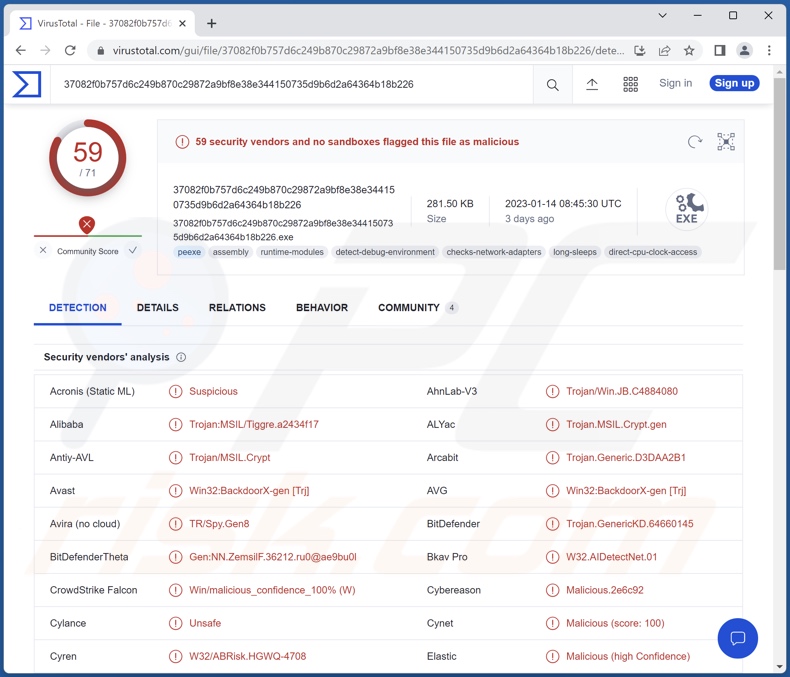
Vagus malware overview
The following overview is based on Vagus RAT's promotional material. After successfully infiltrating a machine, this malware begins collecting relevant device data. This trojan employs anti-detection and persistence-ensuring techniques by disabling the Microsoft Defender and Windows Task Manager. It can also use the latter to manage running processes. Additionally, Vagus can cause Blue Screen errors.
The RAT can operate without raising using suspicion by creating hidden environments and navigating them thusly. Vagus is capable of making hidden desktops and cloning various browsers (e.g., Google Chrome, Mozilla Firefox, Microsoft Edge, Opera, Brave, 360, Comodo, etc.), email clients (e.g., Outlook, Thunderbird, Foxmail, etc.), and cryptocurrency wallets (e.g., Armory, AtomicWallet, Coinomi, Exodus, Guarda, Jaxx, etc.). By using this feature, this trojan might be able to gain control over victims' accounts and abuse them to generate revenue.
The RAT can also manage files and even infiltrate/execute them – hence, it is capable of causing chain infections (i.e., downloading/installing trojans, ransomware, etc.). Vagus targets passwords and has keylogging abilities (i.e., keystroke recording). Another spyware feature that this malware has is recording audio and video via integrated/attached microphones and cameras.
Vagus has "spam" functionalities, which implies that this trojan can add infected devices to botnets and use them to distribute spam mail. This malicious program can operate as a cryptocurrency miner, i.e., abuse system resources to generate cryptocurrency.
To summarize, the presence of software like Vagus on devices may result in multiple system infections, decreased system performance or failure, data loss, hardware damage, severe privacy issues, financial losses, and identity theft.
If you believe that your computer is infected with the Vagus RAT (or other malware), we strongly advise you to use an anti-virus and eliminate it without delay.
| Name | Vagus remote access trojan |
| Threat Type | Trojan, password-stealing virus, banking malware, spyware. |
| Detection Names | Avast (Win32:BackdoorX-gen [Trj]), Combo Cleaner (Trojan.GenericKD.64660145), ESET-NOD32 (A Variant Of MSIL/Agent.DIZ), Kaspersky (HEUR:Trojan.MSIL.Crypt.gen), Microsoft (Trojan:Win32/Tiggre), Full List Of Detections (VirusTotal) |
| Symptoms | Trojans are designed to stealthily infiltrate the victim's computer and remain silent, and thus no particular symptoms are clearly visible on an infected machine. |
| Distribution methods | Infected email attachments, malicious online advertisements, social engineering, software 'cracks'. |
| Damage | Stolen passwords and banking information, identity theft, the victim's computer added to a botnet. |
| Malware Removal (Windows) |
To eliminate possible malware infections, scan your computer with legitimate antivirus software. Our security researchers recommend using Combo Cleaner. Download Combo CleanerTo use full-featured product, you have to purchase a license for Combo Cleaner. 7 days free trial available. Combo Cleaner is owned and operated by RCS LT, the parent company of PCRisk.com. |
Remote Access Trojan examples
We have analyzed countless malware samples; Pupy, Ekipa, RomCom, and ArrowRAT are just some examples of RATs that we have inspected recently.
These trojans tend to have a broad range of functionalities, ranging from ones geared towards information theft to those intended for causing chain infections. However, regardless of how malware operates – its presence on a system endangers device and user safety. Therefore, all threats must be eliminated immediately upon detection.
How did Vagus infiltrate my computer?
According to Vagus' promotional material, this trojan can self-proliferate via USB flash drives. It has also been observed being spread through deceptive Google Ads that redirect to malicious websites. The sites typically offer this malware under the guise of genuine software or pirated programs.
However, Vagus might be distributed using other methods as well. Generally, malware is proliferated using phishing and social engineering tactics.
The most popular malware distribution methods include: drive-by (stealthy/deceptive) downloads, online scams, malicious attachments/links in spam mail (e.g., emails, PMs/DMs, SMSes, etc.), malvertising, untrustworthy download sources (e.g., freeware and free file-hosting websites, Peer-to-Peer sharing networks, etc.), illegal program activation tools ("cracks"), and fake updates.
How to avoid installation of malware?
We strongly recommend downloading only from official and verified channels. It is essential to activate and update software using functions/tools provided by legitimate developers, as illegal activation ("cracking") tools and third-party updaters may contain malware.
Another recommendation is to treat incoming mail with caution. The attachments and links found in dubious/irrelevant emails and other messages – must not be opened, as they can be malicious. We advise being careful while browsing since fake and dangerous online content typically appears ordinary and innocuous.
It must be emphasized that having a reputable anti-virus installed and kept updated is crucial to device and user safety. Security programs must be used to run regular system scans and to remove detected threats/issues. If you believe that your computer is already infected, we recommend running a scan with Combo Cleaner Antivirus for Windows to automatically eliminate infiltrated malware.
Screenshot of the website used to promote and sell Vagus RAT:
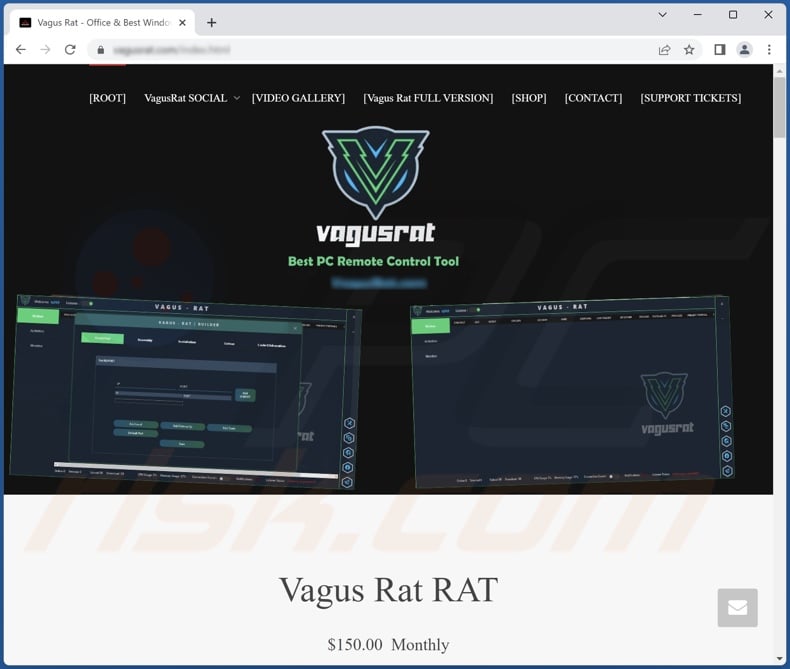
Screenshots of Vagus RAT's admin panel:
Instant automatic malware removal:
Manual threat removal might be a lengthy and complicated process that requires advanced IT skills. Combo Cleaner is a professional automatic malware removal tool that is recommended to get rid of malware. Download it by clicking the button below:
DOWNLOAD Combo CleanerBy downloading any software listed on this website you agree to our Privacy Policy and Terms of Use. To use full-featured product, you have to purchase a license for Combo Cleaner. 7 days free trial available. Combo Cleaner is owned and operated by RCS LT, the parent company of PCRisk.com.
Quick menu:
How to remove malware manually?
Manual malware removal is a complicated task - usually it is best to allow antivirus or anti-malware programs to do this automatically. To remove this malware we recommend using Combo Cleaner Antivirus for Windows.
If you wish to remove malware manually, the first step is to identify the name of the malware that you are trying to remove. Here is an example of a suspicious program running on a user's computer:

If you checked the list of programs running on your computer, for example, using task manager, and identified a program that looks suspicious, you should continue with these steps:
 Download a program called Autoruns. This program shows auto-start applications, Registry, and file system locations:
Download a program called Autoruns. This program shows auto-start applications, Registry, and file system locations:

 Restart your computer into Safe Mode:
Restart your computer into Safe Mode:
Windows XP and Windows 7 users: Start your computer in Safe Mode. Click Start, click Shut Down, click Restart, click OK. During your computer start process, press the F8 key on your keyboard multiple times until you see the Windows Advanced Option menu, and then select Safe Mode with Networking from the list.

Video showing how to start Windows 7 in "Safe Mode with Networking":
Windows 8 users: Start Windows 8 is Safe Mode with Networking - Go to Windows 8 Start Screen, type Advanced, in the search results select Settings. Click Advanced startup options, in the opened "General PC Settings" window, select Advanced startup.
Click the "Restart now" button. Your computer will now restart into the "Advanced Startup options menu". Click the "Troubleshoot" button, and then click the "Advanced options" button. In the advanced option screen, click "Startup settings".
Click the "Restart" button. Your PC will restart into the Startup Settings screen. Press F5 to boot in Safe Mode with Networking.

Video showing how to start Windows 8 in "Safe Mode with Networking":
Windows 10 users: Click the Windows logo and select the Power icon. In the opened menu click "Restart" while holding "Shift" button on your keyboard. In the "choose an option" window click on the "Troubleshoot", next select "Advanced options".
In the advanced options menu select "Startup Settings" and click on the "Restart" button. In the following window you should click the "F5" button on your keyboard. This will restart your operating system in safe mode with networking.

Video showing how to start Windows 10 in "Safe Mode with Networking":
 Extract the downloaded archive and run the Autoruns.exe file.
Extract the downloaded archive and run the Autoruns.exe file.

 In the Autoruns application, click "Options" at the top and uncheck "Hide Empty Locations" and "Hide Windows Entries" options. After this procedure, click the "Refresh" icon.
In the Autoruns application, click "Options" at the top and uncheck "Hide Empty Locations" and "Hide Windows Entries" options. After this procedure, click the "Refresh" icon.

 Check the list provided by the Autoruns application and locate the malware file that you want to eliminate.
Check the list provided by the Autoruns application and locate the malware file that you want to eliminate.
You should write down its full path and name. Note that some malware hides process names under legitimate Windows process names. At this stage, it is very important to avoid removing system files. After you locate the suspicious program you wish to remove, right click your mouse over its name and choose "Delete".

After removing the malware through the Autoruns application (this ensures that the malware will not run automatically on the next system startup), you should search for the malware name on your computer. Be sure to enable hidden files and folders before proceeding. If you find the filename of the malware, be sure to remove it.

Reboot your computer in normal mode. Following these steps should remove any malware from your computer. Note that manual threat removal requires advanced computer skills. If you do not have these skills, leave malware removal to antivirus and anti-malware programs.
These steps might not work with advanced malware infections. As always it is best to prevent infection than try to remove malware later. To keep your computer safe, install the latest operating system updates and use antivirus software. To be sure your computer is free of malware infections, we recommend scanning it with Combo Cleaner Antivirus for Windows.
Frequently Asked Questions (FAQ)
My computer is infected with Vagus malware, should I format my storage device to get rid of it?
No, most malicious programs can be removed without resorting to formatting.
What are the biggest issues that Vagus malware can cause?
Threats associated with a malware infection depend on the program's capabilities on the cyber criminals' goals. Vagus is a RAT – a type of malware designed to enable remote access/control over infected machines. This trojan has various harmful functionalities, and it can be used for a likewise broad range of purposes. Generally, such infections can result in decreased system performance or failure, data loss, hardware damage, severe privacy issues, financial losses, and identity theft.
What is the purpose of Vagus malware?
In most cases, malware infections are used for profit. However, these attacks can be motivated by the cyber criminals' need for amusement, personal grudges, or political/geopolitical leanings.
How did Vagus malware infiltrate my computer?
Vagus has been observed being distributed through malicious websites offering "legitimate software" or pirated programs. These sites were promoted through malicious Google Ads. According to Vagus' promotional material, it is capable of self-spreading through USB flash drives.
However, this RAT might be distributed using other methods, e.g., drive-by downloads, spam emails/messages, online scams, dubious download channels (e.g., freeware and third-party websites, P2P sharing networks, etc.), illegal software activation ("cracking") tools, fake updaters, and so on.
Will Combo Cleaner protect me from malware?
Yes, Combo Cleaner is designed to detect and eliminate threats. It is capable of removing most of the known malware infections. However, it must be stressed that running a complete system scan is essential – since high-end malicious software typically hides deep within systems.
Share:

Tomas Meskauskas
Expert security researcher, professional malware analyst
I am passionate about computer security and technology. I have an experience of over 10 years working in various companies related to computer technical issue solving and Internet security. I have been working as an author and editor for pcrisk.com since 2010. Follow me on Twitter and LinkedIn to stay informed about the latest online security threats.
PCrisk security portal is brought by a company RCS LT.
Joined forces of security researchers help educate computer users about the latest online security threats. More information about the company RCS LT.
Our malware removal guides are free. However, if you want to support us you can send us a donation.
DonatePCrisk security portal is brought by a company RCS LT.
Joined forces of security researchers help educate computer users about the latest online security threats. More information about the company RCS LT.
Our malware removal guides are free. However, if you want to support us you can send us a donation.
Donate






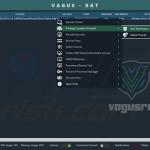
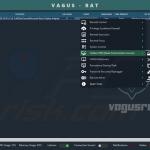
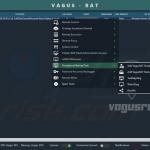
▼ Show Discussion